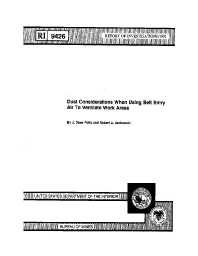Mining Publication: Dust Considerations When Using Belt Entry Air to Ventilate Work Areas
Original creation date: January 1992
In this U.S. Bureau of Mines study, four underground respirable dust surveys were conducted to determine factors affecting belt entry dust levels and how using belt air to ventilate work areas affected dust exposures. Belt entry dust levels on the surveyed longwall and continuous miner sections averaged 0.59 and 0.26 Mg/m3, respectively. The stageloader-crusher contributed an additional 0.5 to 0.9 Mg/m3 of dust to belt air, while the feeder-breaker contributed 0 to 0.2 Mg/m3 of dust. A 1,000-ft increase in belt entry length or a 200- to 500-st-per-shift increase in production resulted in roughly a 0.1-Mg/m3 increase in dust. Using the belt entry as an intake entry on the continuous miner section appeared to reduce dust levels by 0.1 to 0.3 Mg/m3 during cutting. Belt air was not used to ventilate the face on the longwall section.
Authors: JD Potts, RA Jankowski
Report of Investigations - January 1992
NIOSHTIC2 Number: 10011449
Pittsburgh, PA: U.S. Department of the Interior, Bureau of Mines, RI 9426, 1992 Jan; :1-12
See Also
- The Effects of Water Spray Placement for Controlling Respirable Dust and Face Methane Concentrations
- Equivalency of a Personal Dust Monitor to the Current United States Coal Mine Respirable Dust Sampler
- Investigation into the Practical Use of Belt Air at US Longwall Operations
- Investigation of Coal Properties and Airborne Respirable Dust Generation
- Laboratory Evaluation of Pressure Differential-based Respirable Dust Detector Tube
- Laboratory Testing To Quantify Dust Entrainment During Shield Advance
- New Tools To Monitor Personal Exposure To Respirable Coal Mine Dust
- Performance of a Light Scattering Dust Monitor at Various Air Velocities: Results of Sampling in the Active Versus the Passive Mode
- Relationship of Coal Seam Parameters and Airborne Respirable Dust at Longwalls
- Using Ventilation Control Technology to Reduce Respirable Dust Exposures at U.S. Metal/Nonmetal Mining Operations
- Content source: National Institute for Occupational Safety and Health, Mining Program


 ShareCompartir
ShareCompartir
